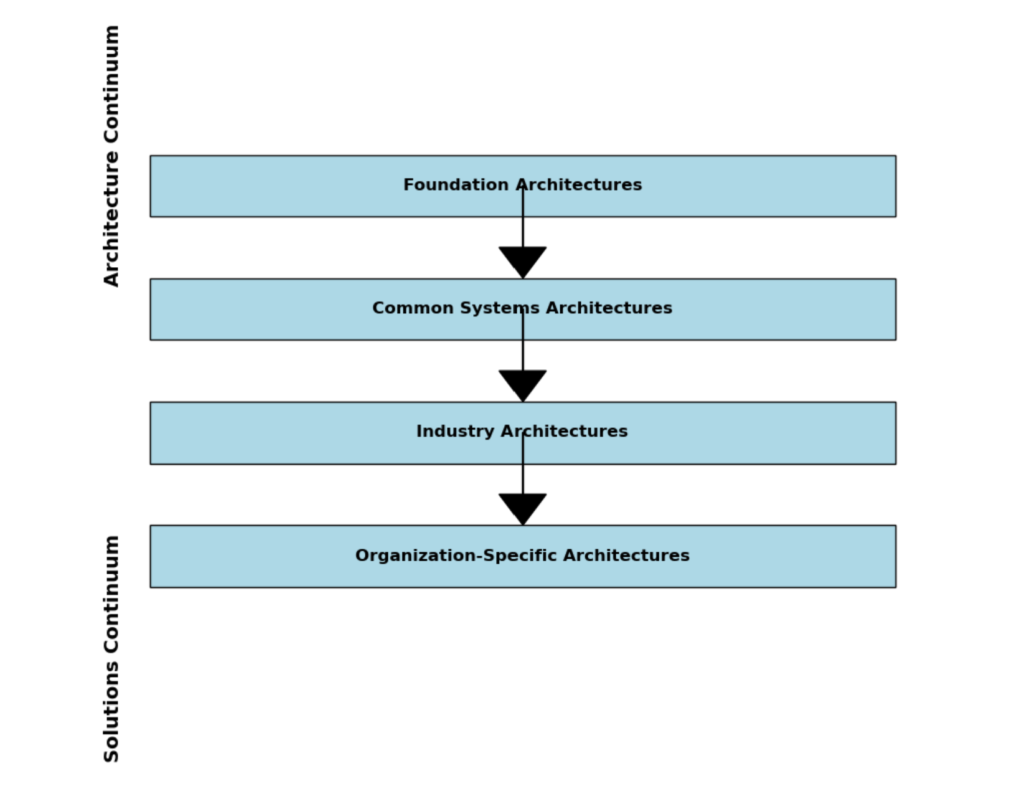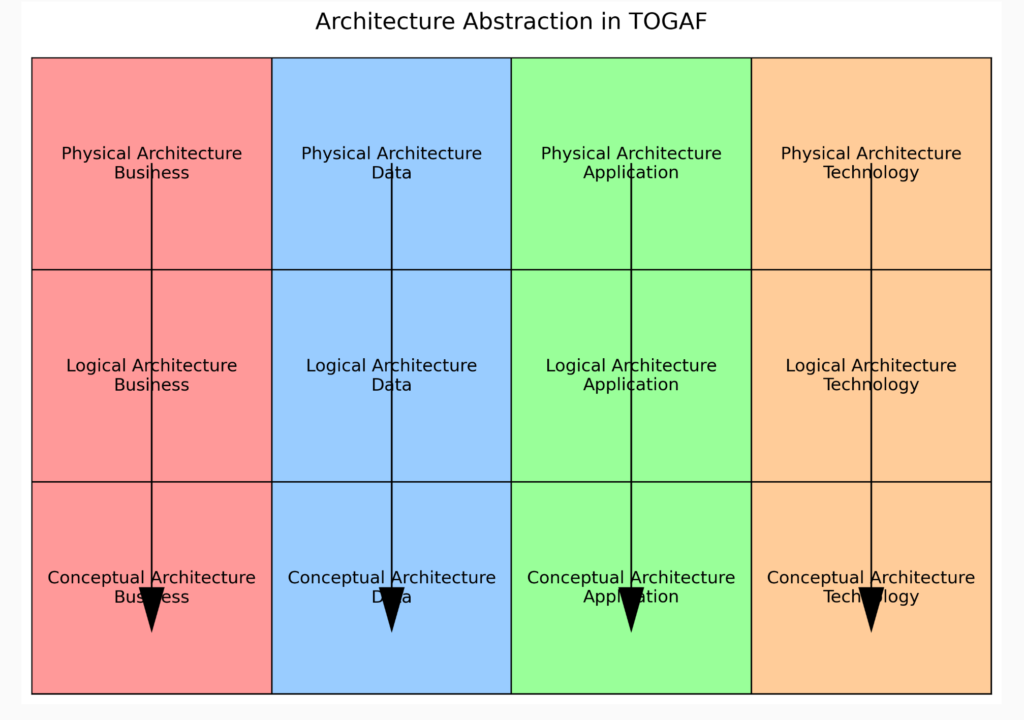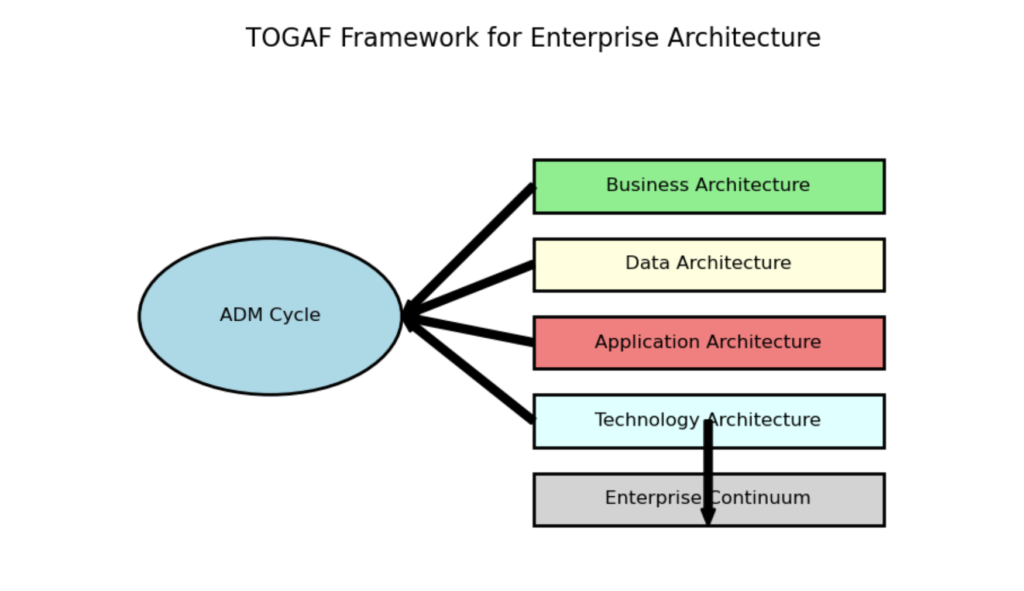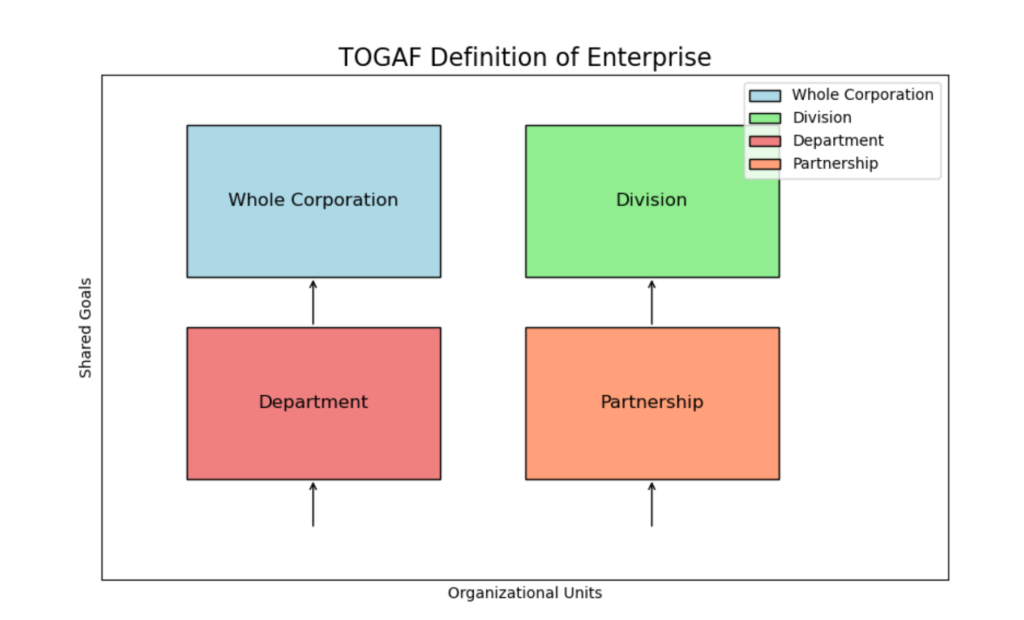-
In enterprise architecture, one size rarely fits all. Organizations need a way to adapt architectural assets to their unique needs while still leveraging industry standards and best practices. TOGAF addresses this challenge through the concept of the Enterprise Continuum—a powerful model for organizing and evolving architectural assets.
🧱 What is the Enterprise Continuum?
The Enterprise Continuum is a classification mechanism in TOGAF that helps architects understand and manage the evolution of architecture assets. It spans from generic, foundational architectures to highly specific, organization-tailored solutions.
It consists of two key parts:
- Architecture Continuum: Describes the progression of architectural models from abstract to concrete.
- Solutions Continuum: Describes the implementation of those models in real-world solutions.
🧩 Visualizing the Enterprise Continuum
Here’s a diagram that illustrates the structure of the Enterprise Continuum:

This diagram shows how architecture evolves from Foundation Architectures to Organization-Specific Architectures, with the Architecture Continuum guiding the design and the Solutions Continuum guiding implementation.
🔍 Key Layers of the Continuum
1. Foundation Architectures
- Generic building blocks and standards (e.g., TCP/IP, identity management).
- Often provided by vendors or open standards bodies.
2. Common Systems Architectures
- Reusable services and platforms (e.g., enterprise service bus, cloud platforms).
- Provide solutions to common problems across industries.
3. Industry Architectures
- Tailored to specific sectors (e.g., banking, healthcare, manufacturing).
- Include regulatory compliance, industry-specific data models, etc.
4. Organization-Specific Architectures
- Customized to meet the unique needs of a specific enterprise.
- Includes internal processes, proprietary systems, and strategic goals.
✅ Real-World Example 1: Global Retail Chain
Foundation Architecture
- Uses standard cloud infrastructure (e.g., AWS, Azure).
- Implements global identity and access management.
Common Systems Architecture
- Deploys a shared e-commerce platform across regions.
- Integrates with payment gateways and logistics APIs.
Industry Architecture
- Adopts retail-specific data models (e.g., product catalogs, inventory).
- Complies with PCI-DSS for payment security.
Organization-Specific Architecture
- Custom loyalty program, regional pricing engines, and in-store kiosk systems.
✅ Real-World Example 2: National Healthcare Network
Foundation Architecture
- Uses open standards like HL7 and FHIR for health data exchange.
Common Systems Architecture
- Implements a national patient ID system and secure messaging.
Industry Architecture
- Aligns with healthcare regulations (e.g., HIPAA, GDPR).
- Includes templates for EHR systems and telemedicine platforms.
Organization-Specific Architecture
- Custom workflows for hospitals, clinics, and insurance providers.
- Integrated mobile apps for patients and doctors.
✅ Real-World Example 3: Government Digital Services
Foundation Architecture
- Leverages open-source platforms and national cloud infrastructure.
Common Systems Architecture
- Shared authentication and citizen identity services.
Industry Architecture
- Public sector frameworks for digital governance and service delivery.
Organization-Specific Architecture
- Custom portals for tax, licensing, and public records.
📝 Summary
The Enterprise Continuum in TOGAF provides a structured way to evolve and classify architectural assets—from foundational standards to organization-specific solutions. It empowers enterprises to reuse proven models, adapt to industry needs, and build architectures that are both robust and flexible. Whether you’re in retail, healthcare, or government, the Enterprise Continuum helps you bridge the gap between theory and implementation.
-
Architecture Abstraction in Enterprise Architecture
- Posted on: June 2, 2025
- by: Anand Pandey
- 0 Comments
In the world of enterprise architecture, managing complexity is a constant challenge. TOGAF (The Open Group Architecture Framework) addresses this by introducing the concept of architecture abstraction—a structured way to view systems at different levels of detail. This approach helps stakeholders—from executives to developers—understand and contribute to the architecture in ways that are meaningful to them.
🧱 What is Architecture Abstraction in TOGAF?
TOGAF promotes the use of three levels of abstraction to describe architecture:
- Conceptual Architecture: High-level view of business goals, capabilities, and stakeholder needs.
- Logical Architecture: Technology-agnostic design of systems, data flows, and application interactions.
- Physical Architecture: Concrete implementation details including platforms, tools, and infrastructure.
Each level builds upon the previous one, ensuring that strategic intent is preserved all the way through to implementation.
🧩 Visualizing Architecture Abstraction
Here’s a clear, high-resolution diagram that illustrates how abstraction levels align with the four architecture domains:

This diagram shows how each abstraction layer—Conceptual, Logical, and Physical—spans across the Business, Data, Application, and Technology domains, creating a cohesive and scalable architecture.
✅ Real-World Example 1: Smart City Traffic Management System
🔹 Conceptual Architecture
- Goal: Reduce traffic congestion and improve commuter experience.
- Capabilities: Real-time traffic monitoring, dynamic signal control, commuter alerts.
🔹 Logical Architecture
- Components: Traffic data aggregator, analytics engine, mobile app interface.
- Data Flow: Sensor data → Analytics → Dashboard & Alerts.
🔹 Physical Architecture
- Technologies: IoT sensors, cloud-based analytics (e.g., AWS Lambda), mobile app (iOS/Android), 5G connectivity.
✅ Real-World Example 2: National Digital Health Platform
🔹 Conceptual Architecture
- Goal: Improve healthcare access and patient outcomes.
- Capabilities: Patient records, telemedicine, prescription management.
🔹 Logical Architecture
- Components: EHR system, video consultation module, pharmacy integration.
- Data Flow: Patient data → Doctor interface → Prescription system.
🔹 Physical Architecture
- Technologies: Cloud-hosted EHR (e.g., Azure), secure video conferencing (e.g., WebRTC), encrypted APIs for pharmacies.
🏷 Suggested Tags
- TOGAF
- Enterprise Architecture
- Architecture Abstraction
- Conceptual Architecture
- Logical Architecture
- Physical Architecture
- Smart City
- Digital Health
- IT Strategy
- Architecture Framework
📝 Summary
Architecture abstraction in TOGAF is a foundational concept that enables clarity, collaboration, and scalability. By separating architecture into conceptual, logical, and physical layers, organizations can ensure that strategic intent is preserved from vision to implementation. Whether you’re building a smart city or a national health platform, abstraction is the key to managing complexity and delivering value.
-
A Framework for Enterprise Architecture
- Posted on: June 2, 2025
- by: Anand Pandey
- 0 Comments
In a world where technology and business are deeply intertwined, organizations need a structured approach to align their IT capabilities with strategic goals. That’s where TOGAF (The Open Group Architecture Framework) comes in—a comprehensive framework for designing, planning, implementing, and governing enterprise architecture.
🧱 What is TOGAF?
TOGAF is a globally recognized framework that provides a methodology and set of tools for developing enterprise architecture. It helps organizations manage complexity, improve decision-making, and ensure that IT investments support business outcomes.
At its core, TOGAF is built around the Architecture Development Method (ADM)—a step-by-step approach to developing and managing enterprise architecture.
🧩 Key Components of the TOGAF Framework
1. Architecture Development Method (ADM)
The ADM is the heart of TOGAF. It provides a structured cycle for developing architecture, from vision to implementation and governance.
2. Architecture Domains
TOGAF divides enterprise architecture into four domains:
- Business Architecture – Defines business strategy, governance, and processes.
- Data Architecture – Structures data assets and data management.
- Application Architecture – Describes individual applications and their interactions.
- Technology Architecture – Details the infrastructure and technology stack.
3. Enterprise Continuum
This is a classification model that helps organize and reuse architectural assets across the enterprise—from generic foundation architectures to specific organizational solutions.
🖼 Visualizing the TOGAF Framework
Here’s a visual diagram that illustrates how the ADM cycle connects with the architecture domains and the Enterprise Continuum:

✅ Real-World Example
Imagine a national education board planning a digital transformation:
- The ADM cycle guides the process from defining the vision to deploying new systems.
- The Business Architecture defines goals like improving student access and digital learning.
- The Data Architecture structures student records, performance metrics, and learning content.
- The Application Architecture includes learning management systems and mobile apps.
- The Technology Architecture covers cloud infrastructure, security, and device management.
- The Enterprise Continuum helps reuse proven models and adapt them to the education sector.
📝 Summary
The TOGAF framework offers a powerful, structured approach to enterprise architecture. By combining the ADM cycle, architecture domains, and the Enterprise Continuum, TOGAF helps organizations align technology with strategy, reduce complexity, and drive innovation. Whether you’re modernizing legacy systems or launching new digital initiatives, TOGAF provides the blueprint for success.
-
The Benefits of Having an Enterprise Architecture
- Posted on: June 2, 2025
- by: Anand Pandey
- 0 Comments
In today’s fast-paced digital world, organizations face increasing pressure to innovate, scale, and adapt—without losing sight of their strategic goals. This is where Enterprise Architecture (EA), as defined by TOGAF (The Open Group Architecture Framework), becomes a powerful enabler.
🧱 What is Enterprise Architecture in TOGAF?
TOGAF defines Enterprise Architecture as a structured framework that helps organizations align their business goals with IT infrastructure, ensuring that every part of the enterprise works together efficiently and effectively.
It breaks down architecture into four key domains:
- Business Architecture
- Data Architecture
- Application Architecture
- Technology Architecture
These domains work together to provide a holistic view of the enterprise.
🌟 Key Benefits of Enterprise Architecture
Here are the core benefits of implementing enterprise architecture using TOGAF:
1. Alignment Between Business and IT
EA ensures that IT initiatives are directly aligned with business strategies, reducing miscommunication and wasted resources.
2. Improved Decision-Making
With a clear architectural roadmap, leaders can make informed decisions based on a comprehensive understanding of systems, dependencies, and impacts.
3. Enhanced Agility
EA provides a flexible foundation that allows organizations to adapt quickly to market changes, regulatory shifts, or new technologies.
4. Reduced Complexity
By standardizing processes and systems, EA simplifies the IT landscape, making it easier to manage, scale, and secure.
🖼 Visualizing the Benefits
Here’s a visual diagram that illustrates how these benefits flow from a well-structured enterprise architecture:

✅ Real-World Example
Consider a multinational retail company undergoing digital transformation. By adopting TOGAF:
- The business team defines goals like improving customer experience and expanding into new markets.
- The IT team uses EA to align infrastructure, applications, and data strategies with those goals.
- As a result, the company launches a unified e-commerce platform faster, with fewer integration issues and better scalability.
📝 Summary
Enterprise Architecture, when implemented through TOGAF, offers a structured approach to aligning business and IT. It empowers organizations to make smarter decisions, respond faster to change, and reduce operational complexity. In a world where agility and clarity are key, EA is not just a technical tool—it’s a strategic advantage.
-
The Purpose of Enterprise Architecture
- Posted on: June 2, 2025
- by: Anand Pandey
- 0 Comments
In enterprise architecture, clarity of scope is essential. TOGAF (The Open Group Architecture Framework) offers a flexible and inclusive definition of “enterprise” that helps architects align technology with business goals effectively.
🔍 What Does TOGAF Mean by “Enterprise”?
TOGAF defines an enterprise as:
“Any collection of organizations that has a common set of goals.”
This means an enterprise isn’t limited to a single company. It could be:
- A corporation
- A business unit or department
- A government agency
- A partnership between multiple organizations
The key is the shared purpose—not the organizational boundaries.
🎯 Why Define the Enterprise?
The purpose of defining the enterprise in TOGAF is to:
- Establish a clear architectural scope
- Align IT systems with strategic business objectives
- Identify relevant stakeholders and their concerns
- Ensure consistency across systems, processes, and governance
By clearly defining the enterprise, architects can focus on delivering value where it matters most.
✅ Real-World Example
Imagine you’re working on a digital platform for a public-private healthcare initiative. The platform involves:
- A government health department
- A private hospital network
- A third-party logistics provider for medical supplies
Even though these are separate organizations, they share a common goal: improving healthcare delivery. In TOGAF terms, they collectively form an enterprise for the purpose of this architecture.
🧩 Visualizing the TOGAF Enterprise Scope
Here’s a diagram that illustrates how different organizational units can be part of a single enterprise when they share common goals:

📝 Summary
Understanding the purpose of defining an enterprise in TOGAF is foundational to successful architecture work. It ensures that all efforts are aligned with shared goals, regardless of organizational boundaries. Whether you’re working within a single department or across multiple entities, TOGAF’s flexible definition helps you focus on delivering strategic value through architecture.
-
In TOGAF (The Open Group Architecture Framework), the term “Enterprise” has a specific and flexible meaning that goes beyond just a single company or organization.
🔍 TOGAF Definition of “Enterprise”
According to TOGAF:
“An enterprise is any collection of organizations that has a common set of goals.”
This could be:
- A whole corporation
- A division within a corporation
- A government agency
- A partnership of multiple organizations
- Even a department or a project team, depending on the context
The key idea is that the enterprise is defined by shared goals and objectives, not necessarily by legal or organizational boundaries.
🧠 Why This Matters in Architecture
In enterprise architecture, defining the scope of the enterprise is crucial because it determines:
- What systems and processes are included
- Who the stakeholders are
- What goals the architecture must support
✅ Example
Let’s say you work at Dell Technologies.
- If you’re designing architecture for Dell’s global e-commerce platform, your “enterprise” might be the entire Dell Digital division.
- If you’re focused only on the Cart & Checkout team, your enterprise might be just that specific product team.
- If Dell partners with a logistics company to streamline delivery, and you’re designing a shared system, the “enterprise” could include both organizations.
Here’s a visual diagram that illustrates the TOGAF concept of an Enterprise:

🔍 Diagram Explanation:
- Whole Corporation: The broadest scope, representing the entire organization.
- Division: A major business unit within the corporation.
- Department: A smaller, focused team or function within a division.
- Partnership: A collaboration between different organizations.
All of these are considered part of an “enterprise” in TOGAF as long as they share common goals.
🧩 Summary
Term Meaning in TOGAF Context Enterprise A group with shared goals (not just a company) Scope Defined by purpose, not legal structure Example A department, a business unit, or a multi-org partnership
Tag